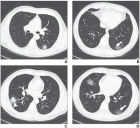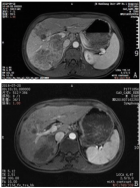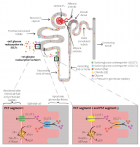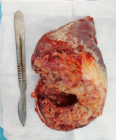Abstract
Review Article
Localization of the occluded vessel in acute myocardial infarction
Samir Rafla* and Amr Kamal
Published: 18 February, 2020 | Volume 5 - Issue 1 | Pages: 029-033
This is a review of features in ECG to diagnose the culprit artery responsible for the infarction. Localization of the occluded vessel in acute myocardial infarction is important for many reasons: to know which artery is to dilate and stent; to assess the severity of the lesion; to compare with the echocardiographic area with hypokinesia or akinesia and to differentiate the recent from the old occluded vessel. The ST-segment changes in 12-lead ECG form the basis of diagnosis, management, and prognosis.
Read Full Article HTML DOI: 10.29328/journal.jccm.1001082 Cite this Article Read Full Article PDF
Keywords:
Infarct related artery; Culprit vessel; Acute coronary syndrome; Coronary angiography; Magnetic resonance imaging; Myocardial infarction; Electrocardiogram; ST-elevation
References
- Amsterdam EA, Wenger NK, Brindis RG, Casey DE, Ganiats TG, et al. 2014 AHA/ACC guideline for the management of patients with non-ST- elevation acute coronary syndromes: executive summary: a report of the American College of Cardiology/American Heart Association Task Force on Practice Guidelines. Circulation. 2014; 130: 2354–2394. PubMed: https://www.ncbi.nlm.nih.gov/pubmed/25249586
- Kerensky RA, Wade M, Deedwania P, Boden WE, Pepine CJ, et al. Revisiting the culprit lesion in non-Q-wave myocardial infarction. Results from the VANQWISH trial angiographic core laboratory. J Am Coll Cardiol. 2002; 39: 1456–1463. PubMed: https://www.ncbi.nlm.nih.gov/pubmed/11985907
- Kim HW, Farzaneh-Far A, Kim RJ. Cardiovascular magnetic resonance in patients with myocardial infarction: current and emerging applications. J Am Coll Cardiol. 2009; 55: 1–16. PubMed: https://www.ncbi.nlm.nih.gov/pubmed/20117357
- Brener SJ, Milford-Beland S, Roe MT, Bhatt DL, Weintraub WS, et al. Culprit-only or multivessel revascularization in patients with acute coronary syndromes: an American College of Cardiology National Cardiovascular Database Registry report. Am Heart J. 2008; 155: 140–146. PubMed: https://www.ncbi.nlm.nih.gov/pubmed/18082505
- Budge LP, Salerno M. The role of cardiac magnetic resonance in the evaluation of patients presenting with suspected or confirmed acute coronary syndrome. Cardiol Res Pract. 2011; 2011: 605785. PubMed: https://www.ncbi.nlm.nih.gov/pubmed/22028981
- Amier RP, Smulders MW, van der Flier WM, Bekkers SCAM, Zweerink A, et al. Long-term prognostic implications of previou PubMed:s silent myocardial infarction in patients presenting with acute myocardial infarction. JACC Cardiovasc Imaging. 2018; 11: 1773–1781. PubMed: https://www.ncbi.nlm.nih.gov/pubmed/29680352
- Midgette AS, Griffith JL, Califf RM, Laks MM, Dietz SB, et al. Prediction of the Infarct-Related Artery in Acute Myocardial Infarction by a Scoring System Using Summary ST-Segment and T-Wave Changes. Am J Cardiol. 1996; 78: 389-395. PubMed: https://www.ncbi.nlm.nih.gov/pubmed/8752181
- Thejanandan Reddy CS, Rajasekhar D, Vanajakshamma V. Electrocardiographic localization of infarct related coronary artery in acute ST elevation myocardial infarction. J Clin Sci Res 2013; 2:151-60.
- Baltazar RF. Acute Coronary Syndrome: ST Elevation Myocardial Infarction. In: Baltazar RF, editor. Basic and bedside electrocardiography. 1st edition. Baltimore: Lippincott Williams and Wilkins. 2009; 337-339.
- Popma JJ. Coronary arteriography. In: Bonow OR, Mann DL, Zipes DP, Libby P, Braunwald E, editors. Braunwald's heart disease. A textbook of cardiovascular medicine. 9th edition. St. Louis: Elsevier Saunders. 2012; 428-431.
- Wagner GS, Macfarlane P, Wellens H, Josephson M, Gorgels A, et al. AHA/ACCF/HRS recommendations for the standardization and interpretation of the electrocardiogram: part VI: acute ischemia/infarction: a scientific statement from the American Heart Association Electrocardiography and Arrhythmias Committee, Council on Clinical Cardiology; the American College of Cardiology Foundation; and the Heart Rhythm Society. Endorsed by the International Society for Computerized Electrocardiology. J Am Coll Cardiol 2009; 53: 1003-1011. PubMed: https://www.ncbi.nlm.nih.gov/pubmed/19281933
- Fiol M, Carillo A, Cygankiewicz I, Velasco J, Riera M, et al. A New Electrocardiographic Algorithm to Locate the Occlusion in Left Anterior Descending Coronary Artery. Clin Cardiol. 2009; 32: E1-E6. PubMed: https://www.ncbi.nlm.nih.gov/pmc/articles/PMC6652907/
- Zimetbaum P, Krishnan S, Gold A, Carrozza JP II, Josephson M. Usefulness of ST segment elevation in lead III exceeding that of lead II for identifying the location of the totally occluded coronary artery in inferior wall myocardial infarction. Am J Cardiol 1998; 81: 918-919. PubMed: https://www.ncbi.nlm.nih.gov/pubmed/9555783
- Zimetbaum PJ, Josephson ME. Use of the electrocardiogram in acute myocardial infarction. N Engl J Med. 2003; 348: 933-940. PubMed: https://www.ncbi.nlm.nih.gov/pubmed/12621138
- Wellens HJJ. Determining the size of the area at risk, the severity of ischemia, and identifying the site of occlusion in the culprit coronary artery. In: Wellens HJJ, Gorgels APM, Doevendans PA, editors. The ECG in acute myocardial infarction and unstable angina: diagnosis and risk stratification. 2nd edition. Dordrecht: Kluwer Academic Publishers. 2003; 13-43.
- Herz I, Assali AR, Adler Y, Solodky A, Sclarovsky S. New electrocardiographic criteria for predicting either the right or left circumflex artery as the culprit coronary artery in inferior wall acute myocardial infarction. Am J Cardiol. 1997; 80: 1343-1345. PubMed: https://www.ncbi.nlm.nih.gov/pubmed/9388111
- Bairey CN, Shah K, Lew AS, Hulse S. Electrocardiographic differentiation of occlusion of the left circumflex versus the right coronary artery as a cause of inferior acute myocardial infarction. Am J Cardiol. 1987; 60: 456-459. PubMed: https://www.ncbi.nlm.nih.gov/pubmed/3630927
- Bayes de Luna A, Goldwasser D, Fiol M, Bayes Genis A. Surface electrocardiography. In: Fuster V, Walsh RA, Harrington RA' editors. Hurst's the heart.13th edition. New York: McGraw Hill. 2011; 350-358.
- Hasdai D, Birnbaum Y, Herz I, Sclarovsky S, Mazur A, et al. ST segment depression in lateral limb leads in inferior wall acute myocardial infarction: implications regarding the culprit artery and the site of obstruction. Eur Heart J. 1995; 16: 1549-1553. PubMed: https://www.ncbi.nlm.nih.gov/pubmed/8881846
- Verouden NJ, Barwari K, Koch KT, Henriques JP, Baan J, et al. Distinguishing the right coronary artery from the left circumflex coronary artery as the infarct-related artery in patients undergoing primary percutaneous coronary intervention for acute inferior myocardial infarction. Europace. 2009; 11: 1517-1521. PubMed: https://www.ncbi.nlm.nih.gov/pubmed/19706635
- Rott D, Nowatzky J, Teddy Weiss A, Chajek-Shaul T, Leibowitz D. ST Deviation Pattern and Infarct-related Artery in Acute Myocardial Infarction. Clin Cardiol. 2009; 32: E29–E32. PubMed: https://www.ncbi.nlm.nih.gov/pubmed/19816991
- Gorgels AP, Engelen DJ, Wellens HJ. Lead aVR, a mostly ignored but very valuable lead in clinical electrocardiography. J Am Coll Cardiol. 2001; 38: 1355–1356. PubMed: https://www.ncbi.nlm.nih.gov/pubmed/11691507
- Yamaji H, Iwasaki K, Kusachi S, Murakami T, Hirami R, et al. Prediction of acute left main coronary artery obstruction by 12-lead ECG. ST segment elevation in lead aVR with less ST segment elevation in lead V1. J Am Coll Cardiol. 2001; 38: 1348–1354. PubMed: https://www.ncbi.nlm.nih.gov/pubmed/11691506
- Thrudeep S, Geofi G, Rupesh G, Abdulkhadar S. Dilemma of localization of culprit vessel by electrocardiography in acute myocardial infarction. Indian Heart J. 2016; 68(Suppl 2): S15–S17. PubMed: https://www.ncbi.nlm.nih.gov/pubmed/27751270
- Heslop JJ, Narala K, Banga S, Mungee S. Anteroseptal ST elevation myocardial infarction and non-dominant right coronary artery lesion involving acute marginal branch: a dilemma in decision making. JACC. 2015;
- Jothieswaran A, Body R. BET 2: Diagnosing acute myocardial infarction in the presence of ventricular pacing: can Sgarbossa criteria help? Emerg Med J. 2016; 33: PubMed: https://www.ncbi.nlm.nih.gov/pubmed/27539980
- Sgarbossa EB, Pinski SL, Barbagelata A, Underwood DA, Gates KB, et al. Electrocardiographic Diagnosis of Evolving Acute Myocardial Infarction in the Presence of Left Bundle-Branch Block. N Engl J Med. 1996; 334: 481-487. PubMed: https://www.ncbi.nlm.nih.gov/pubmed/8559200
Figures:

Figure 1

Figure 2

Figure 3

Figure 4

Figure 5
Similar Articles
-
Left Atrial Remodeling is Associated with Left Ventricular Remodeling in Patients with Reperfused Acute Myocardial InfarctionChristodoulos E. Papadopoulos*,Dimitrios G. Zioutas,Panagiotis Charalambidis,Aristi Boulbou,Konstantinos Triantafyllou,Konstantinos Baltoumas,Haralambos I. Karvounis,Vassilios Vassilikos. Left Atrial Remodeling is Associated with Left Ventricular Remodeling in Patients with Reperfused Acute Myocardial Infarction. . 2016 doi: 10.29328/journal.jccm.1001001; 1: 001-008
-
Short and Medium-Term Evaluation of Patients in Coronary Post-Angioplasty: Préliminary results at the Cardiology Department of the Hospital University Aristide Le Dantec of Dakar (Senegal): Study on 38 CasesDioum M*,Aw F,Masmoudi K,Gaye ND,Sarr SA,Ndao SCT, Mingou J,Ngaidé AA,Diack B,Bodian M,Ndiaye MB,Diao M,Ba SA. Short and Medium-Term Evaluation of Patients in Coronary Post-Angioplasty: Préliminary results at the Cardiology Department of the Hospital University Aristide Le Dantec of Dakar (Senegal): Study on 38 Cases. . 2017 doi: 10.29328/journal.jccm.1001006; 2: 008-012
-
Indications and Results of Coronarography in Senegalese Diabetic Patients: About 45 CasesNdao SCT*,Gaye ND,Dioum M,Ngaide AA,Mingou JS,Ndiaye MB, Diao M,Ba SA. Indications and Results of Coronarography in Senegalese Diabetic Patients: About 45 Cases. . 2017 doi: 10.29328/journal.jccm.1001007; 2: 013-019
-
Procedure utilization, latency and mortality: Weekend versus Weekday admission for Myocardial InfarctionNader Makki,David M Kline,Arun Kanmanthareddy,Hansie Mathelier,Satya Shreenivas,Scott M Lilly*. Procedure utilization, latency and mortality: Weekend versus Weekday admission for Myocardial Infarction. . 2017 doi: 10.29328/journal.jccm.1001008; 2: 020-025
-
Spontaneous rupture of a giant Coronary Artery Aneurysm after acute Myocardial InfarctionOğuzhan Çelik,Mucahit Yetim,Tolga Doğan,Lütfü Bekar,Macit Kalçık*,Yusuf Karavelioğlu. Spontaneous rupture of a giant Coronary Artery Aneurysm after acute Myocardial Infarction. . 2017 doi: 10.29328/journal.jccm.1001009; 2: 026-028
-
Incidence of symptom-driven Coronary Angiographic procedures post-drug-eluting Balloon treatment of Coronary Artery drug-eluting stent in-stent Restenosis-does it matter?Victor Voon*,Dikshaini Gumani,Calvin Craig,Ciara Cahill,Khalid Mustafa,Terry Hennessy,Samer Arnous,Thomas Kiernan. Incidence of symptom-driven Coronary Angiographic procedures post-drug-eluting Balloon treatment of Coronary Artery drug-eluting stent in-stent Restenosis-does it matter?. . 2017 doi: 10.29328/journal.jccm.1001011; 2: 035-041
-
Investigation of Retinal Microvascular Findings in patients with Coronary Artery DiseaseTolga Doğan*,Osman Akın Serdar,Naile Bolca Topal,Özgür Yalçınbayır. Investigation of Retinal Microvascular Findings in patients with Coronary Artery Disease. . 2017 doi: 10.29328/journal.jccm.1001012; 2: 042-049
-
A rare Congenital Coronary Artery Anomaly: Woven Right Coronary Artery associated with Myocardial InfarctionTolga Doğan,Mucahit Yetim,Lütfü Bekar,Oğuzhan Çelik,Macit Kalçık*,Yusuf Karavelioğlu. A rare Congenital Coronary Artery Anomaly: Woven Right Coronary Artery associated with Myocardial Infarction. . 2017 doi: 10.29328/journal.jccm.1001013; 2: 050-051
-
Value of electrocardiographic T wave inversion in lead aVL in prediction of Mid Left Anterior Descending Stenosis in patients with stable Coronary Artery diseaseGehan Magdy*,Awad Yousef. Value of electrocardiographic T wave inversion in lead aVL in prediction of Mid Left Anterior Descending Stenosis in patients with stable Coronary Artery disease. . 2017 doi: 10.29328/journal.jccm.1001015; 2: 056-062
-
Assessment of risk factors and MACE rate among occluded and non-occluded NSTEMI patients undergoing coronary artery angiography: A retrospective cross-sectional study in Multan, PakistanIbtasam Ahmad,Muhammad Haris,Amnah Javed,Muhammad Azhar*. Assessment of risk factors and MACE rate among occluded and non-occluded NSTEMI patients undergoing coronary artery angiography: A retrospective cross-sectional study in Multan, Pakistan. . 2018 doi: 10.29328/journal.jccm.1001023; 3: 023-030
Recently Viewed
-
Investigation of Stain Patterns from Diverse Blood Samples on Various SurfacesSonia Rajkumari*. Investigation of Stain Patterns from Diverse Blood Samples on Various Surfaces. J Forensic Sci Res. 2024: doi: 10.29328/journal.jfsr.1001061; 8: 028034
-
Prevalence of Risk factors of Non Communicable Diseases amongst Medical Students, Kanpur, Uttar Pradesh, IndiaLakshmi Singh*, Anju Gahlot, Atul Kumar Singh. Prevalence of Risk factors of Non Communicable Diseases amongst Medical Students, Kanpur, Uttar Pradesh, India. J Community Med Health Solut. 2024: doi: 10.29328/journal.jcmhs.1001048; 5: 057-061
-
Psychosis in Parkinson’s Disease and Current Management Trends- an Updated Review of LiteratureRajib Dutta*. Psychosis in Parkinson’s Disease and Current Management Trends- an Updated Review of Literature. J Neurosci Neurol Disord. 2023: doi: 10.29328/journal.jnnd.1001078; 7: 027057
-
Enhancing adipose stem cell chondrogenesis: A study on the roles of dexamethasone, transforming growth factor β3 and ascorbate supplements and their combinationBernard J Van Wie*,Arshan Nazempour##,Chrystal R Quisenberry##,Nehal I Abu-Lail. Enhancing adipose stem cell chondrogenesis: A study on the roles of dexamethasone, transforming growth factor β3 and ascorbate supplements and their combination. J Stem Cell Ther Transplant. 2017: doi: 10.29328/journal.jsctt.1001004; 1: 028-051
-
Sinonasal Myxoma Extending into the Orbit in a 4-Year Old: A Case PresentationJulian A Purrinos*, Ramzi Younis. Sinonasal Myxoma Extending into the Orbit in a 4-Year Old: A Case Presentation. Arch Case Rep. 2024: doi: 10.29328/journal.acr.1001099; 8: 075-077
Most Viewed
-
Evaluation of Biostimulants Based on Recovered Protein Hydrolysates from Animal By-products as Plant Growth EnhancersH Pérez-Aguilar*, M Lacruz-Asaro, F Arán-Ais. Evaluation of Biostimulants Based on Recovered Protein Hydrolysates from Animal By-products as Plant Growth Enhancers. J Plant Sci Phytopathol. 2023 doi: 10.29328/journal.jpsp.1001104; 7: 042-047
-
Sinonasal Myxoma Extending into the Orbit in a 4-Year Old: A Case PresentationJulian A Purrinos*, Ramzi Younis. Sinonasal Myxoma Extending into the Orbit in a 4-Year Old: A Case Presentation. Arch Case Rep. 2024 doi: 10.29328/journal.acr.1001099; 8: 075-077
-
Feasibility study of magnetic sensing for detecting single-neuron action potentialsDenis Tonini,Kai Wu,Renata Saha,Jian-Ping Wang*. Feasibility study of magnetic sensing for detecting single-neuron action potentials. Ann Biomed Sci Eng. 2022 doi: 10.29328/journal.abse.1001018; 6: 019-029
-
Pediatric Dysgerminoma: Unveiling a Rare Ovarian TumorFaten Limaiem*, Khalil Saffar, Ahmed Halouani. Pediatric Dysgerminoma: Unveiling a Rare Ovarian Tumor. Arch Case Rep. 2024 doi: 10.29328/journal.acr.1001087; 8: 010-013
-
Physical activity can change the physiological and psychological circumstances during COVID-19 pandemic: A narrative reviewKhashayar Maroufi*. Physical activity can change the physiological and psychological circumstances during COVID-19 pandemic: A narrative review. J Sports Med Ther. 2021 doi: 10.29328/journal.jsmt.1001051; 6: 001-007

HSPI: We're glad you're here. Please click "create a new Query" if you are a new visitor to our website and need further information from us.
If you are already a member of our network and need to keep track of any developments regarding a question you have already submitted, click "take me to my Query."























































































































































